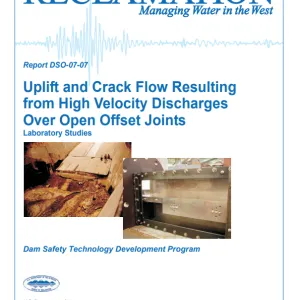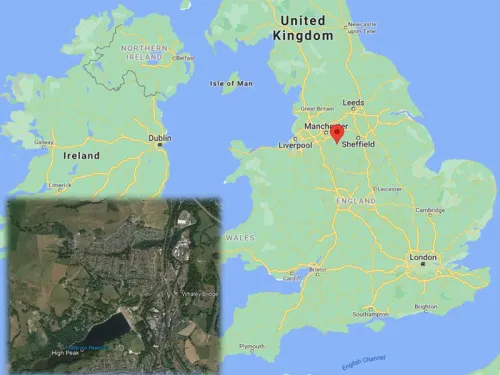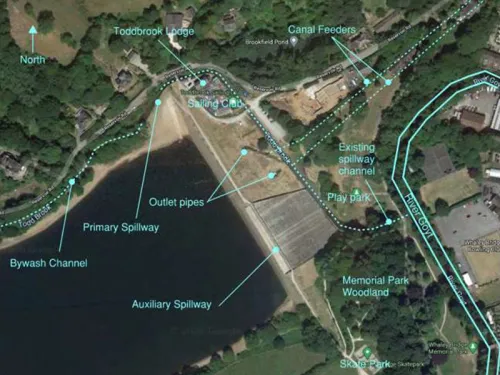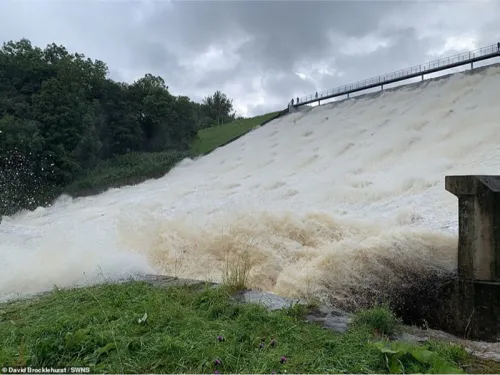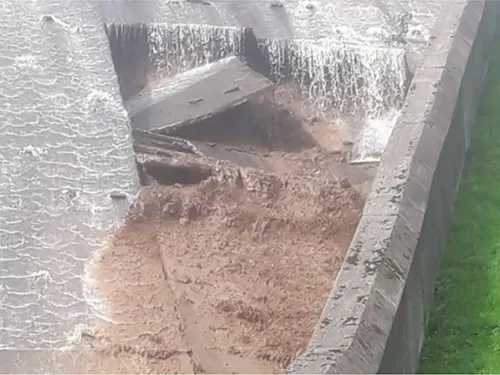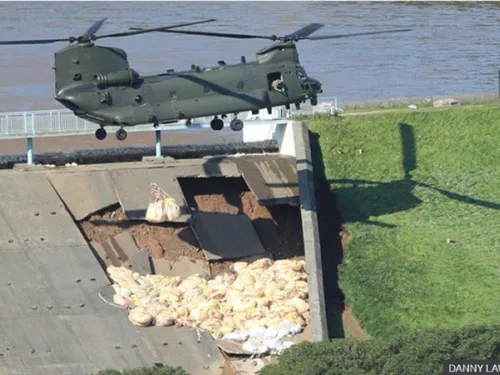Toddbrook Reservoir Dam (England, 2019)
History of the Dam
Toddbrook Reservoir is located just upstream of the town of Whaley Bridge in the High Peak area of Derbyshire, England. The almost 80-foot tall embankment was constructed between 1837 and 1840 for water supply, with a central puddle core and outer shells of more granular earthfill. At the time of construction, Toddbrook Reservoir Dam was the tallest dam in the UK, capable of storing 1,040 acre-feet. Since 2012, the dam has been owned and operated by the Canal & River Trust.
Toddbrook Dam (sometimes referred to as Whaley Bridge Dam) was originally constructed with a single (primary) spillway at the left abutment of the dam. Records indicate that the reservoir was maintained at the primary spillway crest, normal pool elevation or higher for several months each winter. In 1964, the primary spillway was damaged during a flood event, which led to modifications to increase spillway capacity.
A concrete auxiliary spillway was completed in 1970 on the central portion of the downstream face of the embankment, with a crest length of 250 feet at about a foot above the primary spillway crest. The auxiliary spillway chute was constructed on the downstream shoulder fill where materials were described as “permeable and well graded, albeit with zones of variability” and it was concluded that the downstream shoulder consisted of free draining material, based on the low phreatic surface in the downstream portion of the dam [Balmforth, 2020].
Auxiliary Spillway Incident
The auxiliary spillway suffered a serious incident on August 1, 2019 after almost a week of intense rainfall occurring during two separate events, the second and more severe of which had an estimated annual exceedance of 1% (i.e. a return period of 100 years). The reservoir peaked during the evening of July 31 and distress in the auxiliary spillway chute panels was observed starting the next morning, August 1, as follows [Balmforth, 2020]:
-
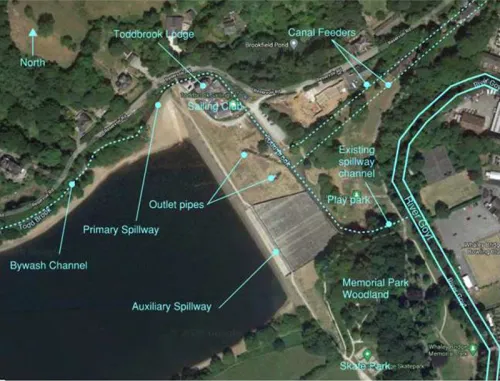 Toddbrook Dam key features. (Photo Source: Spillway Options Report, 2020)Toddbrook Dam key features. (Photo Source: Spillway Options Report, 2020)
Toddbrook Dam key features. (Photo Source: Spillway Options Report, 2020)Toddbrook Dam key features. (Photo Source: Spillway Options Report, 2020) - 8:30 am: A member of the public reported having seen muddy water spurting up from the joints in the spillway. After the event, panels at the foot of the chute were seen to be pushed upwards and it was apparent that a slurry of water and embankment fill had been removed from the foundation and discharged in some quantity.
- 9:00 am: The first panel is thought to have collapsed. This was reported at 9:45 am by a second member of the public as a section of concrete about “15 feet x 20 feet” being broken away and that the “earth bank is starting to wash away”. A void could be seen to have formed beneath the slab. Note that at this stage, discharge down the spillway had significantly reduced.
- 10:00 am: Operations staff arrived on site and opened the draw-off and scour valves. A loud crack was heard. Four panels were observed to have fallen into the void.
- 2:00 pm: The next row up of panels started to collapse. Quantities of eroded material were still being discharged from the void at this stage.
- 2:30 pm: The next column of panels collapsed. The top row of panels started to collapse, and the left-hand chute wall was undermined.
Following the incident, an Independent Review Panel [Balmforth, 2020] developed the following series of likely events that led to the failure of the auxiliary spillway chute:
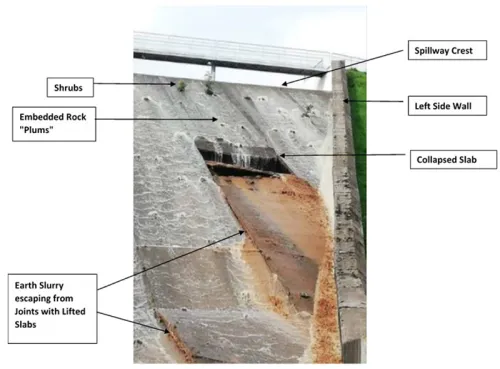
- While the auxiliary spillway was operating, stagnation pressures developed in at least one upstream crack or joint above the slab that initially collapsed.
- The rate of water injection exceeded the drainage capability of the downstream shoulder fill and the fill liquefied into a “slurry” of water, clay, silt and sand. Note that no underdrains were provided beneath the chute slab.
- The liquefied fill raised the chute slabs to the point that slurry flowed beneath them, eventually lifting and displacing some of the lower chute slabs. Silt and mud were exiting the sides of the raised lower slabs during this time.
- As material was removed beneath the upper slabs, a large void developed.
- As the flow through the auxiliary spillway reduced, the uplift pressure beneath the slab decreased and the initial slab collapsed into the void.
- As the saturated fill and water slowly exited, reduced flows continued and the scour hole widened, leading to the collapse of further slabs and the undermining of the left side of the chute.
Lessons Learned
The Toddbrook Dam auxiliary spillway water conveyance (chute) design was inadequate, with the following design flaws contributing to the incident:
- Thin (6-inch) concrete floor slabs
- Floor slabs only had minor reinforcement (only placed at bottom of the slabs)
- Some dowel bars and water bars were provided in transverse joints between slabs, but not in the longitudinal joints between the slabs
- No underdrains for the spillway chute
- No cutoff between the concrete spillway crest and the puddle clay core of the dam
Toddbrook dam had inconsistent maintenance of the auxiliary spillway. The sealant in open joints and cracks had failed and vegetation was growing through cracks and joints. This lack of maintenance and the vegetation in transverse joints contributed to stagnation pressures. This was likely a contributing factor to the initiation of the spillway failure.
Independent forensic investigations provide lessons to be learned from dam failures and incidents and can improve the state of practice for dam safety practitioners.
In the case of Toddbrook Dam, the UK undertook multiple investigations analyzing the physical factors that led to the incident, as well as the role of dam owners and regulators, and lessons learned / recommendations for UK dam safety as a whole [Balmforth 2020; Hughes, 2020; Balmforth, 2021].
Intervention can stop or minimize consequences of a dam failure.
More than 1,500 people were evacuated from their homes and businesses in Whaley Bridge during this incident for six days. An immediate drawdown of the reservoir was initiated, and urgent intervention measures were taken to stabilize the dam, including pumping, diverting inflows, increased surveillance and monitoring, and dropping sandbags into the scour hole from a helicopter. In the end, the Toddbrook Dam did not breach, and the reservoir remains drained while plans are underway to replace the auxiliary spillway.
Dam incidents and failures can often be attributed to human factors.
A natural tendency is for systems to move towards failure, and so continual human effort is needed to maintain order and prevent failure, especially throughout the life of a structure like Toddbrook Dam, which is more than 180 years old. A year before the spillway failure, an inspector identified the risk posed by the inadequate spillway design and recommended measures to address the deficiencies. However, he did not convey any sense of urgency or propose any interim risk reduction measures (such as a drawdown of the reservoir), so no actions to address these known deficiencies had been completed.
References:
(1) Balmforth, D. (2020). Toddbrook Reservoir Independent Review Report. Open Government License, The UK National Archives, Crown. 10 February 2020.
(2) Hughes, A. (2020). Report on the Nature and Root Cause of the Toddbrook Reservoir Auxiliary Spillway Failure on 1st August 2019. Dams & Reservoirs Ltd, Canal & River Trust.
(3) Spillway Options Report. (2020). Toddbrook Reservoir. Canal & River Trust.
(4) Balmforth. (2021). Independent Reservoir Safety Review Report. Open Government License, The UK National Archives, Crown March 2021.
This case study summary was peer-reviewed by Bill Fiedler, HDR; and Thomas Hepler, Schnabel Engineering.
Lessons Learned
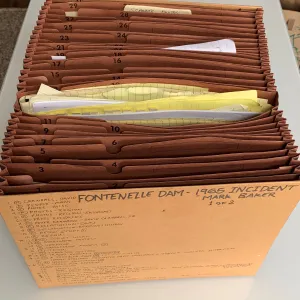
A complete and thorough dam record is essential.
Learn more
Concrete-lined spillways are vulnerable to significant damage and potential reservoir breach if flows are not safely contained within the conveyance structure.
Learn more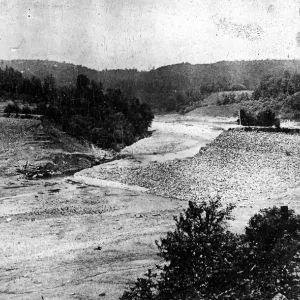
Dam incidents and failures can fundamentally be attributed to human factors.
Learn more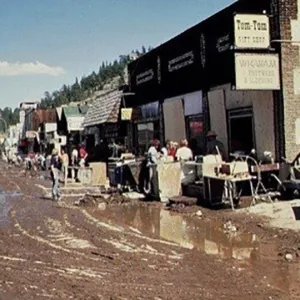
Dams should be thoroughly assessed for risk using a periodic risk review process including a site inspection, review of original design/construction/performance, and analysis of potential failure modes and consequences of failure.
Learn more
Intervention can stop or minimize consequences of a dam failure. Warning signs should not be ignored.
Learn more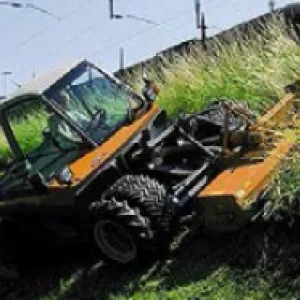
Regular operation, maintenance, and inspection of dams is important to the early detection and prevention of dam failure.
Learn more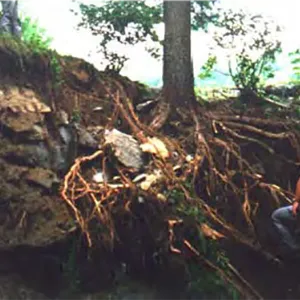
Uncontrolled vegetation on and around dams can hinder inspection and lead to serious structural damage, significant maintenance costs, and possible failure.
Learn moreAdditional Lesson Learned Information
- Independent Forensic Investigations provide lessons to be learned from dam failures and incidents and can improve the state of practice for dam safety practitioners.

Delivering Benefits through Evidence: Lessons from Historical Dam Incidents
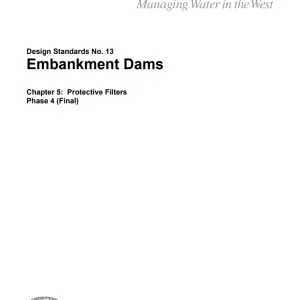
Design Standards No. 13: Embankment Dams - Chapter 5

Design Standards No. 14
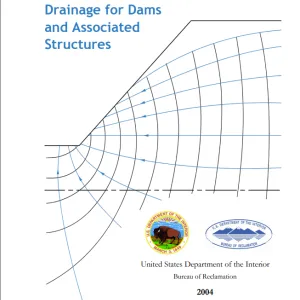
Drainage for Dams and Associated Structures

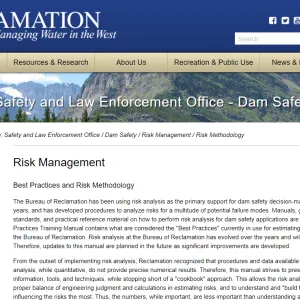
Risk Management - Best Practices and Risk Methodology

Spillway Chute Joints - The Devil's in the Details
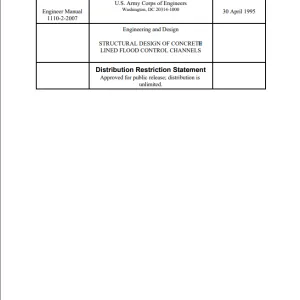
Structural Design of Concrete Lined Flood Control Channels

Toddbrook Reservoir Independent Review Report
